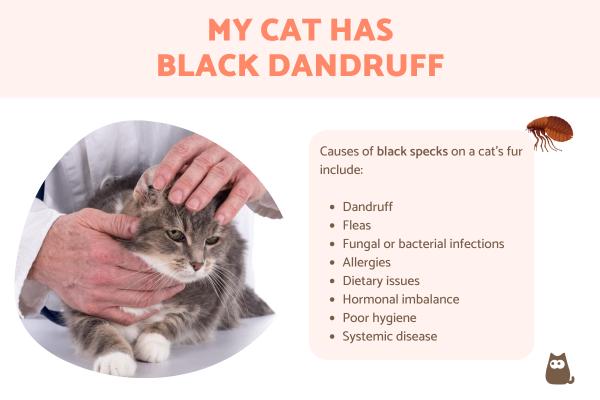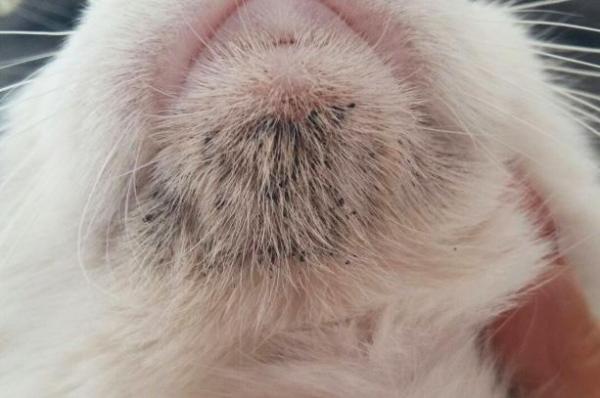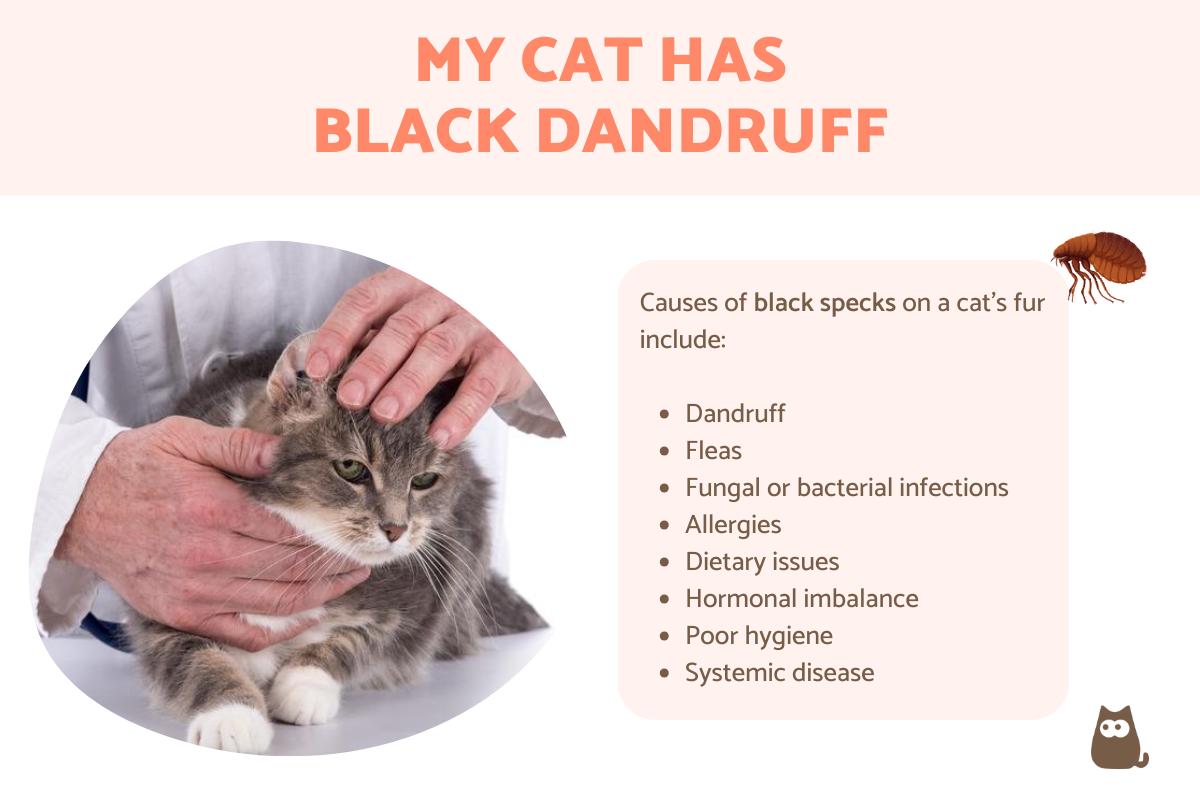My Cat Has Black Dandruff



See files for Cats
We might think that black specks in a cat's fur are dandruff, but it is possible they are a symptom of parasites such as fleas. Sometimes the black dandruff can be under the chin, around the ears or in other common areas. These locations can help us to determine the cause of the cat's black specks. Dandruff in cats is a condition which causes skin flakes to proliferate on their fur, but it is not usually a serious condition. Black dandruff can be normal dandruff which has accumulated dirt, but it can also be a sign of a serious health issue which can't be ignored.
At AnimalWised, we find out why my cat has black dandruff. We look at the causes of black specks in cat fur, as well as what treatment and prevention methods are available.
Why do cats have dandruff?
Cats devote a large portion of their day to hygiene maintenance, even engaging in social grooming for various purposes. It's not a bad idea to groom your cat yourself, especially if they don't have another cat with which they can groom socially. The cat's coat provides vital functions to the overall health of the animal. It regulates their body temperature, as well as protects them from injury and from the harmful UV rays of the sun.
There are instances when a cat can develop dandruff, i.e. the presence of dry and flaky skin on their coat. This may or may not be related to hygiene. The causes of dandruff in cats include the following:
- Dry skin: insufficient humidity, especially in indoor environments, can lead to dry skin and dandruff in cats.
- Dietary issues: poor nutrition or an imbalanced diet lacking essential fatty acids can contribute to skin problems and dandruff.
- Allergies: cats can be allergic to certain foods, environmental factors or grooming products which lead to skin issues.
- Parasites: infestations of fleas, mites or other parasites can irritate the skin and cause dandruff.
- Underlying health conditions: conditions such as dermatitis, fungal infections or hormonal imbalances can manifest as dandruff.
In these cases, the dandruff will appear as white skin flakes. It is possible they can mix with some dirt on the cat's coat, but this would only happen if they were particularly unhygienic. Since cats are usually very hygienic animals, poor coat condition is often the result of a systemic health disease.
My cat has black dandruff on their fur
What appears as black dandruff on the cat's coat is likely not to be actual dandruff. These black specks on the cat's fur may appear like deal pieces of skin, but they are likely due to one of the following causes:
- Flea dirt: flea dirt is the feces of fleas and appears as small, dark specks. If your cat has fleas, their droppings may resemble black dandruff.
- Dirt or environmental debris: cats that spend time outdoors may accumulate dirt or debris in their fur, leading to the appearance of dark particles.
- Fungal or bacterial infections: infections of the skin such as ringworm can cause changes in the coat, including the presence of dark flakes.
- Allergies: allergic reactions to certain foods, grooming products or environmental factors can affect the skin and coat, leading to issues like black dandruff.
- Medical conditions: underlying health conditions, such as seborrhea or dermatitis, may cause changes in skin pigmentation and contribute to the appearance of dark flakes.
Some of these causes of black dandruff in cats are self-explanatory. We provide more detail about some of the most important in the sections below.

Black dandruff in cats due to external parasites
If your cat has dandruff which looks black, it is possible there is the presence of fleas. These external parasites are hematophagous. This means they feed on the blood of their host, often causing severe irritation in the process. As our cats are scrupulous in their hygiene, if the cat has external fleas, it is common for them to ingest these parasites as they fulfil their grooming ritual. Even if we don't observe the fleas at first sight, it is possible we might find black dandruff or what look like pieces of grit in their fur.
We can take a sample of these black specks on the cat's skin and set them on some white paper. Add a drop of water and see if it fragments like dried blood. If it does so, it is likely the excrement of fleas which is made up digested blood. If your cat has what looks like black dandruff on any part of its fur, it is more likely than not signaling the presence of fleas.
To combat these unpleasant insects, we must contact our vet to prescribe the most appropriate antiparasitic for the individual cat. There is a wide range of products available, but the vet can take into consideration any other symptoms as well as the overall health of the feline. Prevention of fleas is important to all cats, even if they are housecats. Fleas could come in from the outside via many different methods, especially if the house is shared with a dog which does go outside.
If we discover our cat has an acute infestation, we can find products which will rid your cat of fleas in a matter hours. It's important to know these fleas are perhaps only the visible part of a larger infestation. There may also be eggs and pupae present which will not move in the same way. For this reason, we don't simply need to treat the cat, but any part of their environment with which they may have interacted. Vacuum the floors, the sofas and anywhere they may have passed through. Wash any sheets, pillows or blankets they have been using.
Once we get rid of this burst of parasites from our cat, we need to ensure they don't come back. The best way to do this is to implement a deworming schedule. This will help keep fleas at bay. Fleas can cause irritation thanks to the saliva they impart during a bite. They can also carry disease which is why a suitable vaccination schedule also needs to be carried out.
Black dandruff due to feline acne
Just because their skin is covered in fur, doesn't mean it is impossible for them to develop spots on their skin. There are other reasons for black specks on cat skin which aren't fleas. When these spots are predominantly located underneath the cat's chin, it is likely a case of acne. This is a dermatological condition which can occur in cats of all ages, but it usually does not present symptoms other than these little black spots.
The black specks caused by feline acne can be difficult to distinguish from flea excrement, but their localization under the chin will suggest acne. It is an inflammatory disorder which affects the hair follicles and is often complicated by secondary infection. Feline acne can also appear on their lips. As this part of the chin rubs against the water or food bowl, sometimes it can be prevented by using a bowl made from different material in case they are allergic to the one they use. Causes of feline acne include:
- Overactive sebaceous glands: cats have sebaceous glands in the chin area and overproduction of oil can lead to the formation of blackheads.
- Poor grooming habits: cats that do not groom themselves adequately or those with plastic food bowls that harbor bacteria may be more prone to acne. Since cats are such hygienic animals, poor coat condition in general could be due to a systemic health issue.
- Contact allergies: sensitivity to certain materials, such as plastic, in food or water bowls may contribute to the development of feline acne.
The black spots of feline acne will turn into papules and pustules if they are allowed to progress. We should visit a vet so they can provide an accurate diagnosis and prescribe the most suitable treatment. This is likely to be a topical medication.
In severe cases, the affected area may appear as an edema (i.e. filled with fluid) and pruritis is also produced. In these cases, the black specks on the cat's skin may be dried blood. This can be very uncomfortable for our cat. It is one of the most common feline skin conditions treated by vets[1] and is relatively treatable, depending on the severity of the case.
Imagen: http://socialrescate1.wixsite.com

Black dandruff due to poor hygiene
While some of the time flea excrement, acne or any type of black colored dandruff might look like dirt, sometimes this is actually what it is. It might not happen as much with housecats, but cats which go outside can get into lots of scrapes. Maybe they looked into a car exhaust pipe or were unable to hide during a rain shower.
Whatever the reason for being dirty, you should be able to away the black specks and it will not look like black dandruff afterwards. It should be relatively easy to discern if it is dirt compared to a parasitical infestation or disease.
While the black specks on your cat's skin and fur may not be fleas, if you see them, you will need to be careful. While sleeping next to your cat is great most of the time, there are reasons to be careful which we detail below:

Keeping a cat's coat healthy
It is so important for a cat's coat to be kept in good condition. Brushing will help remove dead hair which is especially good for long haired cats as well as those who are prone to hairballs.
There are other benefits to grooming your cat. It helps to strengthen the bond between human and animal, mimicking the social grooming they have between each other. Brushing can help relax your cat as well, keeping them purring during times of stress. Importantly, it gives you the opportunity to take a look at the quality of the cat's coat and inspect them for any signs of illness.
This article is purely informative. AnimalWised does not have the authority to prescribe any veterinary treatment or create a diagnosis. We invite you to take your pet to the veterinarian if they are suffering from any condition or pain.
If you want to read similar articles to My Cat Has Black Dandruff, we recommend you visit our Skin problems category.
1. Scott, D. W., Miller, W. H., & Erb, H. N. (2013). Feline Dermatology at Cornell University: 1407 Cases (1988-2003). The Journal of Feline Medical Surgery, 15(4), 307-316.
https://www.ncbi.nlm.nih.gov/pubmed/23186638







